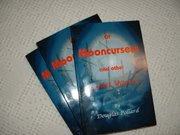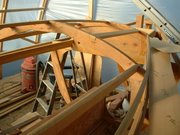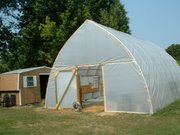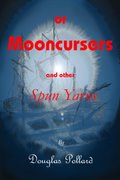sailboats Fair and Fine: read oldest post first.
Here is a little about what I think Wolftrap is. Years ago I owned a Hershoff 23 named TERN she was thirty four foot on deck with a twenty three foot water line. She had a shallow hull and a deep keel I would say the hull drew two and one half foot and the boat drew six and one half feet. Her bottom was slightly rounded with a generous radius where her chines would normally be Her bottom rising upward was also rounded. Up forward he bottom rolled up to give a fine entry. I think she was a modified sharpie in the same sense the class boat Star was. She was fast! Off the wind in good wind she would sail eleven knots and she would do it all day long, not surfing.. Wolftrap I also think is a bit of a modified sharpie her bottom rolls up and is also round some. Yes there was a little bit of compound curve there. Took a sledge hammer to work some of that in at midships she was a slightly 'V, Bottom, in a triangular shape. So amid ships there was a section of straight run. The strait run next to the keel was about eight feet long and out at the chine about two feet long. That section had about six inches of dead rise. Going forward the plating turned upward to create a fine entry. So she was to a degree a modified sharpie with some of the characteristics of Commodore Monroe's Presto ketch. I think she was a near perfect compromise for a plated boat as compared to a well rounded hull like a Presto.
I out ran a fair number of supposedly fast racer cruiser type sailboats to windward. Wolftrap was not faster to windward than those boats could have been. The fault was in the Skippers. Most people often don't understand sailing to windward. There sailing a boat with five thousand ponds of tension on the rigging to keep it all tight. They have a boom van on the main. They draw the boomvang down to pull the curl out of the sail and they have no idea what they have done. They then sheet the main in to the center of the boat and maybe even a little to windward. If you don't have a boom vang you have to sheet in tight so that the top of the sail is pulling up where the wind is blowing. The bottom of the sail is pulling little or none. It doesn't matter that much because the wind is lighter down that low anyway. Sailing like that is a disaster with a boom vang because the whole sail is sheeted in and none of it is pulling properly.
A sprite rig takes care of the problem if you don't sheet it in tight. It is primarily a boom vang eliminator if it is used right. I see sprite rigged boats sailing with the sprite parallel to the water. All it is when used like that is a boom for this you need a boom vang.. If the forward end is not set up higher then the aft end it does not pull the curl out of the sail.
A sail like an airplane wing does not create lift if it is less than seven degrees off the wind and it doesn't create lift if its greater than eighteen degrees off the wind. In which case it just pushes the boat sideways and maybe even backwards if you maintain the same course. Lets say you are sailing 45 degrees to the real wind. But because you are moving the apparent wind comes into play. Now the wind moves toward the bow the boom is sheeted in amidships and it is about twenty degrees to the apparent wind and is not pulling. The top of the sail is about ten degrees to the apparent wind but there is another thing because the sail is billowed out some the leading edges is less than seven degrees and is luffing. The sprite and boomvang both let the bottom of the sail out into that seven degree to eighteen degree range. The boomvang does it with shrouds and spreaders costing a pile of money and increased weight aloft as well. It takes increased ballast to carry it all. The sprite can do it with free standing masts, and very little hardware and you wind up with simular windward ability and very docile down wind running. Because the sprite is holding the aft end of the sail down it is much less likely to broach. If the main does broach there are no shrouds for the sail and sprite to slam up against so you can let the main sheet run.
We delighted in outrunning a lot of the racing boats in the Fishing bay yacht club on a regular basis though we turned down offers to race around the buoys. In addition we often cheated by cutting across the shallows in about 30 inches of water to beat the fleet home for sundowners at the dock. She was referred to by the turtle neck sweater, sport coat, set as that funny looking fast boat. Of course we took offense to that funny looking claim and our welder "Glick" three sheets to the wind, threatened to throw one bank president over board and we almost had a riot on the dock I think the president and his crew may have played football together in college as several had pug noses and all were big. My partner a pretty good diplomat was able to save the day with a bottle of scotch and drinks all around. We were asked to move our boat to a marina on the other side of Stingray point. The marina we were in was owned by a close friend so I was able to talk him out of banning us from his place. I was forced to make some promises for my crew of welders and machinists that I couldn't keep. We had to move down to the York river to a marina that was somewhat more rowdy where we were in alike company. The marina crowd was a bunch of hard drinking power boaters and my gang fit right in.
For the better part of a sumer David and Linda took to sailing. They sailed all up and down the York River and Mobjack bay. They were a part of the lighthouse presrvation group that was busy keeping the New Point lighthouse from falling into the Chesapeake bay so they spent a lot of Sundays out there on that Island with Wolftrap anchored in close. The two of them younger that Bob and I had all there young friends on board a great deal of the time. They should have changed the boat name to Bakini heaven. Every time I saw them Wolftrap was covered in young wives in bekinis. If the duty of a boat is to give please Wolftrap surved her purpose.
After a time they not really being lifelong sailors tired of sailing and moved on to other things leaving my family and I to sail peacefully all over the Chesapeake bay and beyond.
We were considering selling the machine shop. The turbine business was coming to a close. The battleships were ready to go on line so there would be no new orders for blades or turbine rotors. The law required them to carry a complete set of spare parts for the turbines. The Battle ship Missouri, Yorktown and a few others had been commissioned from the moth ball fleet and would be sailing.





